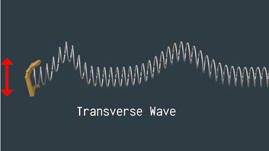Teachers' Domain - Digital Media for the Classroom and Professional Development
User: Preview



Animations and essays were created and written by Dr. Michael Gallis, the Pennsylvania State University.
Teachers who reviewed the collection were Patrick Callahan, Tara Clopper, and David R. McCachren. Instructional designer was Rucha Modak. Multimedia producer was Betsy Hutton. Director of Educational Services, Penn State Public Broadcasting is Dr. Babs Bengtson.

A wave is some sort of physical disturbance that carries energy from one place to another without carrying matter. In this animation a hand moves a slinky up and down to illustrate a transverse wave, a type of wave where the disturbance is at right angles to the direction the wave travels.
Another example is: When fans “do the wave” at a stadium, the disturbance is the motion of the fans rising from their seats, standing, and then returning to their seats. The motion of the fans is up and down, while the disturbance travels around the stadium.
A wave is some sort of physical disturbance that carries energy from one place to another without carrying matter. We often think of water waves when we come across the term, but there are many other types of waves. Our senses of hearing and sight depend upon sound and light waves. These important waves share some similarities but also have some important differences.
Transverse waves are a type of wave where the disturbance is at right angles to the direction the waves travel. When the fans “do the wave” at a stadium, the disturbance is the motion of the fans rising from their seats, standing, and then returning to their seats. The motion of the fans is up and down, while the disturbance travels around the stadium. Another easy way to demonstrate a transverse wave is for two people to take a slinky (or a long coiled spring) and stretch it out above the ground between them. When one person gives their end of a slinky a quick shake up and down, the disturbance quickly travels along the slinky, bouncing off the ends and traveling back and forth along the slinky until the wave fades from view. Another important example of a transverse wave is light.
Transverse waves can occur whenever there is material that will spring back when stretched “sideways”, which essentially limits transverse waves to solids. When liquids and gasses are given a “sideways shake” (as with the slinky), the fluid merely flows instead of springing back. As a result, transverse vibrations can only travel through solid materials.
Earthquakes produce vibrations which create waves that can travel through the earth. Geologists call the transverse waves which travel through the earth S-waves or Shear waves. Because the speed of the S-wave depends upon the materials the wave travels through, monitoring the vibrations created around the globe by an earthquake helps scientists determine the nature of the interior of the earth. For a particular earthquake event, there is a “shadow zone” on the far side of the Earth from the epicenter where S-waves traveling through the earth do not reach. The shadow zone demonstrates that S-waves are unable to go through the Earth’s core, which is an important piece of evidence that scientists use to determine that Earth has a liquid core.
To learn more about basic properties of waves check out What Is a Wave?.
 Loading Standards
Loading Standards Teachers' Domain is proud to be a Pathways portal to the National Science Digital Library.
Teachers' Domain is proud to be a Pathways portal to the National Science Digital Library.
